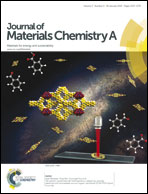Fe3C-based oxygen reduction catalysts: synthesis, hollow spherical structures and applications in fuel cells†
Abstract
We present a detailed study of a novel Fe3C-based spherical catalyst with respect to synthetic parameters, nanostructure formation, ORR active sites and fuel cell demonstration. The catalyst is synthesized by high-temperature autoclave pyrolysis using decomposing precursors. Below 500 °C, melamine-rich microspheres are first developed with uniformly dispersed amorphous Fe species. During the following pyrolysis at temperatures from 600 to 660 °C, a small amount of Fe3C phase with possible Fe–Nx/C active sites are formed, however, with moderate catalytic activity, likely limited by the low conductivity of the catalyst. At high pyrolytic temperatures of 700–800 °C, simultaneous formation of Fe3C nanoparticles and encasing graphitic layers occur within the morphological confinement of the microspheres. With negligible surface nitrogen or iron functionality, the thus-obtained catalysts exhibit superior ORR activity and stability. A new ORR active phase of Fe3C nanoparticles encapsulated by thin graphitic layers is proposed. The activity and durability of the catalysts are demonstrated in both Nafion-based low temperature and acid doped polybenzimidazole-based high temperature proton exchange membrane fuel cells.


 Please wait while we load your content...
Please wait while we load your content...